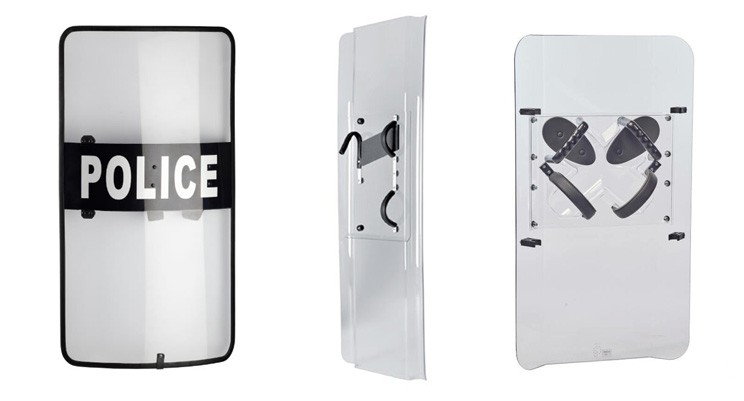Shop by Industry
Industries we support...
Products
START SHOPPING...
EXPLORE by category
Product Series
Resources
Contact
Find a Dealer
While commonly used in ballistic shields, lighting on riot shields proves to be effective as a harmless force multiplier. As we’ve mentioned earlier in this article, rioters do try to pry shields away from officers. As a result, lighting (or other features) should not be added to the shield's front for fear that they will be removed and used against the officer.
Because riot shields are transparent, lighting can be mounted to the inside of the shield and still pass light through. Riots can happen at any time, which means dark and low light situations are commonplace and can make situations more complex. In up close or low light applications, a bright light is disturbing to rioters and limits their ability to move as quickly towards officers.
The light can be used in two ways to de-escalate behavior in a non-lethal manner
Continuous lighting enables the officer to see what's in the immediate vicinity and potentially see hazards sooner. It can also be turned on when needed to deter protesters from getting too close to officers.
Useful for disorientation. Strobing light can temporarily blind an attacker, which stops them and gives the officer time to prepare for the next attack.
A lighting tool like the FoxFury R40 shield light can provide a powerful non-lethal tactical advantage for officers. It also provides an extra layer of safety in these uncertain COVID-19 times when physical/social distancing is critical.
The use of sound technology in a security application is still in development. Some shields come with an acoustic dispersion system to help disperse crowds.
Shock and stun shields produce an electronic stun as a deterrent. These electric shock shields like the NOVA Gen 5 Electronic Stun Capture Shield and SecPro Stun Tech Anti Riot Shield can temporarily immobilize violent protestors. While this may sound extreme, it offers protection from deranged or violent individuals and rabid animals.
This non-lethal option can neutralize threats quickly to protect the public. These shields look intimidating for a reason. They are designed to help resolve conflict through psychological intimidation, thus avoiding physical confrontation.
Officers also use sound, stun, and distraction devices outside of shields as well. These include vehicle-mounted LRAD (long-range acoustic device) sound cannons, pepper spray, tear gas, and electronic distraction devices. As with anything else, officers need to weigh risk versus rewards when considering these options.
Riot shields can vary widely in price from $100 to upwards of $1,000 (USD). Most shields used by law enforcement agencies cost between $100 and $300
Some basic shields on the market are available for under $100. These include airsoft shields like the Evike.com CQB Riot Shield that are appropriate for camera crews, close quarters airsoft training, and simulations.
Depending on what is thrown at them or what they are subjected to, riot shields could have a short life.
Normally, it’s a good idea to replace shields after being used heavily during riots or kept in storage for over 3 - 5 years. If users see cracks or chips in them or seem to lose flexibility, you should consider a replacement.
Given the differences in shields, useful life will vary. Different manufacturers provide different warranties on their shields. This will depend on the manufacturer, shield construction, and damage sustained. If stored properly with minimal damage, riot shields can last indefinitely. That said, several riot shield manufacturers communicate that the shields will last 3-5 years under normal use when stored in proper conditions.
Users must inspect their shields every year to ensure no damage has occurred to them during storage so that they are ready for deployment.
DISCLAIMER: FoxFury does not endorse any of these shields. These models were selected as they show progressive designs and unique features.

EDI RUB-X Riot Shield: has rubber edges to help minimize damage from chipping during riot operations and from damage when dropped.
Armadillo Interlocking Shield: uses an ancient Roman shield design to form a protective and rigid barrier. Officers are protected from bricks and heat with this design, while rubber buffers cover anterior bolt heads for increased public safety.
Mehler P22 Ballistik Pro Anti-Riot Shield: offers protection from riot projectiles and some ballistic threats. Comes with a 40x40cm (16x16 inches) NIJ Level IIIA rated HPPE ballistic plate. It also comes with a vacuum-formed armrest.
These are some of the top riot shield manufacturers (listed alphabetically) who have a proven reputation and experience in public safety and defense.
NOTE: This is not a comprehensive list. We are intentionally not listing manufacturers from Wish.com or Alibaba as these companies are not always established with sufficient testing and accurate claims.
The following resources provided insight that helped compile this article.
Thanks to Tracey Willmott, Mario Cugini, Phillip Spencer and Chris Sfedu for their assistance.



Enter your details below to save your shopping cart for later.